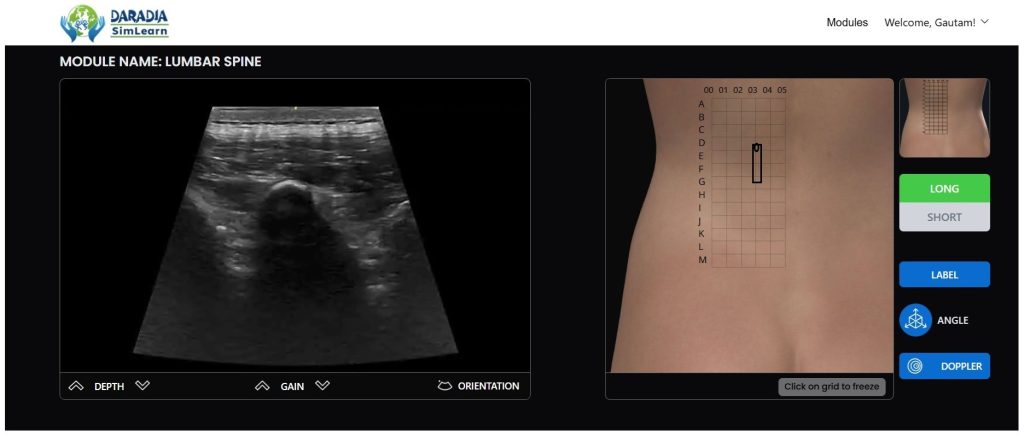Insights from 73 Physicians Using Daradia’s Web-Based Simulator
By Dr. Gautam Das, Director, Daradia Pain Clinic
In musculoskeletal (MSK) ultrasound education, the conventional approach has long depended on cadaveric dissection, volunteer-based workshops, and limited hands-on sessions. While effective, these methods are expensive, time-sensitive, and often inaccessible to physicians in remote or under-resourced regions.
At Daradia Pain Clinic, we faced this gap head-on. As a premier pain education institution training thousands of physicians globally, we asked: can we offer an interactive, repeatable, cadaver-free learning alternative?
The result was the creation of a Web-Based MSK Ultrasound Simulator. Designed to replicate real-time scanning, anatomy identification, and procedure planning, this tool allows learners to navigate simulated scans using authentic ultrasound image datasets.
But does it work? We decided to let the users answer that.
Who Took Part in the Study?
A total of 73 physicians participated in the first phase of our evaluation. These were experienced professionals, many of whom had already undergone cadaveric or volunteer-based ultrasound training.
- Specialty Breakdown:
- Pain Medicine & Anesthesiology: 29
- Anesthesiology: 15
- Pain Medicine: 14
- Orthopedics, Radiology, Physiatry, Neurology: 15+
- Experience:
- Over 50% had more than 3 years of experience in MSK ultrasound
This made their feedback especially meaningful.
What Did They Say? Key Metrics
We asked participants to rate the simulator experience on a scale of 1 to 10:
- Ease of Use: 8.03
- Visual Realism: 8.56
- Confidence Boost in Practice: 8.63
- Satisfaction with Simulator-Based Learning: 8.34
The vast majority (91.8%) had prior hands-on cadaver or volunteer training, making them uniquely qualified to compare.
Simulator vs Cadaveric Training: Head-to-Head Comparison
Participants evaluated how the simulator compared to traditional cadaver-based workshops across three parameters:
| Category | Better | Similar | Worse |
|---|---|---|---|
| Anatomical Accuracy | 29 | 38 | 2 |
| Ease of Use | 37 | 29 | 3 |
| Learning Outcome | 36 | 29 | 4 |
Over 90% of users rated the simulator equal or better than cadaveric training.
This strongly supports the simulator’s role as a serious educational tool.
Why It Works: Repetition and Accessibility
One standout feature praised by users was the ability to repeat scans endlessly. In cadaver labs, each anatomical exposure is fleeting. In our simulator, learners can revisit anatomical planes, repeat scanning techniques, and consolidate their understanding without time pressure.
A fellow shared, “This is the first time I fully grasped the scanning of infraspinatus and teres minor. I couldn’t do that in cadaver labs due to the limited time and crowd.”
This freedom to learn at one’s own pace, anytime and anywhere, is where simulation wins.
What Needs Improvement?
Constructive feedback was equally valuable. Participants asked for:
- Interactive probe movement with haptic feedback
- Needle trajectory visualization for interventions
- Pathology-based cases (e.g., bursitis, frozen shoulder)
We’re actively developing these features for future versions. Unlike cadavers, simulators evolve with feedback.
Why It Matters Globally
Cadaver labs are often confined to urban academic centers. Physicians in smaller towns, rural areas, or low-resource countries rarely access structured MSK ultrasound training.
Our simulator is cloud-based, allowing any doctor with internet access to begin scanning immediately. The basic module is free and already in use by physicians in multiple countries.
96% of users said this simulator should be included in standard MSK ultrasound education programs.
We believe it has the potential to level the playing field in medical education.
What’s Next?
We are currently:
- Expanding the study to collect 200+ physician responses
- Preparing results for publication in peer-reviewed journals
- Adding advanced modules based on user feedback
Our final goal? To establish this simulator as a validated educational standard that complements hands-on learning.
Try It Yourself
The simulator is live, and the feedback form remains open. If you’re a pain physician, anesthesiologist, or ultrasound learner:
✅ Create a free account and try the demo: https://daradiasimlearn.com
✅ Already tried it? Submit your feedback (takes less than 2 mins): https://forms.gle/ZeA82f7cJ6TVz9ww9
Final Thoughts
Simulation in pain medicine is not a futuristic concept anymore—it’s a practical, evolving reality. Our web-based MSK ultrasound simulator is proof that innovation, when backed by physician feedback and constant iteration, can bridge global gaps in training.
This is not just about technology. It’s about empowering the next generation of pain physicians to learn better, faster, and more equitably.
Let’s make high-quality ultrasound education available to all.
Dr. Gautam Das is a global educator, author, and director of Daradia Pain Clinic in Kolkata, India. He has trained more than 4,500 physicians in pain medicine and ultrasound-guided interventions.

